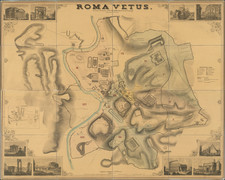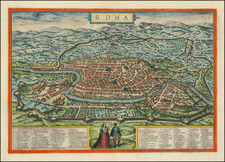Fine example of Covens & Mortier's two-sheet version of Giovanni Battista Falda's 12-sheet bird's-eye view of Rome ( Nuova Pianta et alzata della citta di Roma), first published in 1676.
A striking highly detailed plan of Rome, locating over 250 places in the two keys at the bottom left and right, with inset profile views of seven major Basilicas and Churches.
The map is in the style of a Birdseye view, making it easy to recognize the many buildings, piazzas, bridges, gates, and other features of 17th-century Rome. The present map is dedicated to Pope Alexander VII and includes coats of arms, a magnificent dedication cartouche, and a marvelous allegorical vignette of a Roman Aqueduct at the left-center of the map.
Falda's 1676 wall map of Rome on 12 sheets, showed all the principal buildings, streets, gardens, and houses, inset general map of the region around Rome showing rivers, mountains and major roads, was dedicated to Pope Innocent XI.
Giovanni Battista Falda (c. 1640-1678) was an Italian architect and engraver. He is mainly known for his engravings of contemporary and antique structures in Rome. Falda lived mainly in Rome, where he started to work with the publisher Giovanni Giacomo de Rossi. He was the engraver for Le Fontane di Roma (Fountains in Rome) and for Palazzi di Roma (Palaces of Rome). The latter was published in 1655 in collaboration with Pietro Ferrerio.
Rarity
The map is quite rare. We have had it twice before, and to our knowledge, there was only one appearance at auction in the past 25 years (the Reps copy, Swann March 18, 1999; Lot 296)
Johannes Covens (1697-1774) was a Dutch geographic publisher based in Amsterdam. He is best known for his collaboration with fellow publisher Cornelis Mortier (1699-1783). Pierre Mortier the Elder (1661-1711) had obtained a privilege in 1690 to distribute the works of French geographers in the Netherlands. After his widow continued the business for several years, Cornelis took over in 1719.
In 1721, Mortier forged a partnership with Covens, who had recently married Cornelis’ sister. They published under the joint name of Covens & Mortier. In 1774, upon the death of his father, Johannes Covens II (1722-1794) took over his father’s share. In 1778, the company changed its name to J. Covens & Zoon, or J. Covens & son.
Covens II’s son, Cornelis (1764-1825), later inherited the business and brought Petrus Mortier IV back into the fold. Petrus was the great-grandson of Petrus Mortier I. From 1794, the business was called Mortier, Covens & Zoon, or Mortier, Covens, & Son.
The business specialized in publishing French geographers including Deslisle, Jaillot, and Sanson. They also published atlases, for example a 1725 reissue of Frederik de Wit’s Atlas Major and an atlas, with additions, from the works of Guillaume Delisle. There were also Covens & Mortier pocket atlases and town atlases. The company profited from acquiring plates from other geographers as well. For example, the purchased Pieter van der Aa’s plates in 1730. Finally, they also compiled a few maps in house. At their height, they had the largest collection of geographic prints ever assembled in Amsterdam.
Cornelis Mortier (1699-1783) was a Dutch publisher who specialized in geography. Cornelis’ father, Pierre Mortier the Elder (1661-1711), had obtained a privilege in 1690 to distribute the works of French geographers in the Netherlands. After his widow continued the business for several years, Cornelis took over in 1719.
In 1721, Mortier forged a partnership with Johannes Covens, who had recently married Cornelis’ sister. They published under the joint name of Covens & Mortier. Their firm was one of the largest and most successful in Dutch history and continued in business until the late-nineteenth century.
In 1774, upon the death of his father, Johannes Covens II (1722-1794) took over his father’s share. In 1778, the company changed its name to J. Covens & Zoon, or J. Covens & Son. Covens II’s son, Cornelis (1764-1825), later inherited the business and brought Petrus Mortier IV back into the fold. Petrus was the great-grandson of Petrus Mortier I. From 1794, the business was called Mortier, Covens & Zoon, or Mortier, Covens, & Son.
The business specialized in publishing French geographers including Deslisle, Jaillot, and Sanson. They also published atlases, for example a 1725 reissue of Frederik de Wit’s Atlas Major and an atlas, with additions, from the works of Guillaume Delisle. There were also Covens & Mortier pocket atlases and town atlases. The company profited from acquiring plates from other geographers as well. For example, the purchased Pieter van der Aa’s plates in 1730. Finally, they also compiled a few maps in house. At their height, they had the largest collection of geographic prints ever assembled in Amsterdam.









![[ Ancient Rome ] Urbis Romae Situs Cum IIS Quae Adhuc Conspiciuntur Veter Monumet Relquiis Pyrrho Ligiorio Neap Invent. Romae M. D. LXX](https://storage.googleapis.com/raremaps/img/small/96880.jpg)
![[The Road to Ancient Rome] Waarschynlyke Verbeelding Der Gedaante van den Roomschen Heirweg Buiten de Stad en der Naburige Wegen en Plaatzen aan Dien Gehecht.](https://storage.googleapis.com/raremaps/img/small/88317.jpg)
![Veduta di Piazza Navona sopra le ravine del Circo Agonale [View of the Piazza Navona above the Ruins of the Circus Agonalis; Circus of Domitian]](https://storage.googleapis.com/raremaps/img/small/93192.jpg)

![(Rome) Il Prospetto della Città Leonina, che si vede colla Basilica Vaticana, Ponte, e Castel S. Angelo [The View of the Leonine City, with the Vatican Basilica, Bridge, and Castel Sant'Angelo]](https://storage.googleapis.com/raremaps/img/small/93193.jpg)
